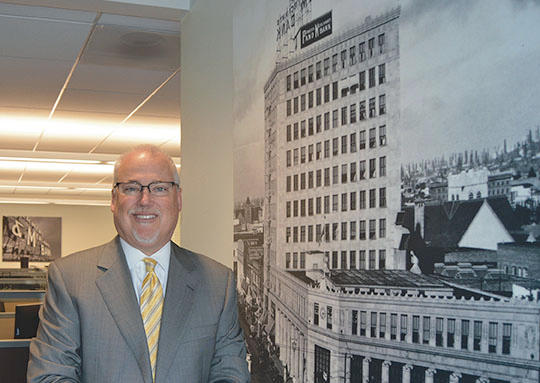Underwriting requirements for residential mortgages remain tight as new regulations aimed at keeping lenders more accountable after the housing crisis continue to roll out, while banks that provide business loans continue to keep standards stringent as well, according to local lenders interviewed by the Business Journal.
Still, financial experts said new business loan activity has been strong this year, while continued record-low interest rates and rising property values have prompted borrowers to tap into equity through residential mortgage refinancing opportunities.
The Federal Reserve has indicated that it may increase interest rates either this December or early next year as the economy continues to improve; however, experts don’t anticipate much of a dramatic impact on lending markets since rates will still be relatively low and are expected to rise only gradually.
For a borrower, qualifying for a home loan in the local market is currently tough since a higher loan amount than in previous years is required as low inventory has driven up home prices, said Michael McCarthy, senior vice president and residential lending manager of Farmers & Merchants Bank in Long Beach.

Michael McCarthy is senior vice president and residential lending manager for Farmers & Merchants Bank, which was founded in 1907. He is pictured at the bank’s Seal Beach office. (Photograph by the Business Journal’s Larry Duncan)
Unlike in other parts of the country where homes are more affordable, in the Los Angeles County market, only about 30 percent of households have the income to qualify for an average home loan, he said, adding that the West Coast is still one of the most expensive markets for residential real estate in the United States.
Additionally, potential homebuyers who qualify are still up against a particularly low inventory of homes, a factor that has created bidding wars and has driven up home prices of mostly low-end residential properties, McCarthy said.
“From a mortgage standpoint, you’ve really got to have your ducks in a row,” he said. “The price of real estate is higher and your average home loan amount is higher . . . If you’re trying to get into the market, you need to be really well prepared and you need to also be prepared for a long, hard run to find a property.”
Steve Puppo, vice president and area sales manager for First Bank in Irvine, said underwriting requirements for home loans remain tight, particularly as the federal government continues to put new consumer protection laws in place years after the mortgage meltdown. New rules have made the process more “detail oriented,” he said.
“I think the pendulum has swung pretty far to the side of tight regulations,” Puppo said. For people who have good credit, have saved money and have sufficient income to buy homes, it’s the same process as it’s always been. What we’ve lost are the people who really had no business buying homes. They’re not able to qualify nowadays.”
An initiative that recently went into effect is the “Know Before You Owe” mortgage disclosure rule, requiring new disclosures for most mortgages that have been applied for on or after October 3.
The new rule, mandated by the Dodd-Frank Act (federal legislation signed into law in 2010 to reform the financial lending industry in response to the Great Recession), requires that consumers be given three business days to review disclosures before closing.
According to the Consumer Financial Protection Bureau (CFPB), the regulatory agency created to carry out financial reforms, the three-day period gives consumers time to review loan terms, to compare the loan with an estimate given early in the process and to ask advisors or the lender any questions.
The new closing disclosure rule was put in place to make the costs and risks of financial products and services “clearer” so consumers can make “better, more informed decisions,” according to the CFPB, which adds that the new rule redesigns the mortgage process to help consumers “shop around to compare offers.”
Although new consumer protection laws in some ways make applying for a mortgage more difficult for borrowers, the new regulations are essentially “good for the industry,” Puppo said.
“Everyone wants to make sure that when people get that mortgage, they know exactly what they’re getting and have an opportunity to read all the fine print, which is good for the industry and keeps people honest,” he said. “I think there’s probably been some abusive lending practices over the past 10 years that have pretty much evened out now.”
McCarthy added that the underwriting process continues to become more detailed, with consumers required to provide more documentation than in the years prior to the recession, which may frustrate consumers. Ultimately, however, the goal is to make it easier for consumers to understand the mortgage process, he said.
In addition, the current market of rising property values and low interest rates have attracted many people to refinance mortgages in order to pull out equity either for lines of credit, capital for business purposes or other investments, McCarthy said.
“What we see at the bank quite a bit is people utilizing the equity in their homes, whether it’s through equity lines or cash out,” he said. “You see a lot of people who do that to try to get access to cash for business reasons, and you see it potentially as an alternative to an SBA (U.S. Small Business Administration) loan.”
Puppo also said that there has been more activity in mortgage refinances recently as interest rates have remained low and property values have increased in the last few years.
“It’s been kind of boom time for people who have wanted to refinance all this time,” he said.
Furthermore, many people are looking to lock in on fixed, 30-year loans at a low interest rate before the Federal Reserve raise rates. Still, experts said even if interest rates rise, they still would be considered low compared to previous years.
McCarthy added that a rise in interest rates might even help the real estate market by slowing down demand and increasing inventory.
On the commercial side, Alan Epperson, regional business banking manager at Wells Fargo’s office in Irvine, said business loan activity has been strong this year. In fact, Wells Fargo’s commercial division in Orange County is projected to see an 18 percent increase in new business loan activity this year compared to 2014, he said.
Epperson attributes the rise in new business loans to a strengthening economy, adding that more businesses are hiring and expanding while in previous years businesses were more cautious about spending. In fact, he said many businesses are having trouble finding qualified skilled workers.
“What I’m hearing in the market is people are hiring and they need more space,” he said. “Those are things that really tell me that we’re climbing out of this, and could see some really strong years coming up.”
Lenders said they haven’t changed underwriting requirements for business loans, although commercial lenders continue to be affected by the strict regulator environment.
“We never really changed our underwriting guidelines,” Epperson said. “We’ve always been open for business. The challenge has been companies meeting that criteria, and I just see a lot more strength out in the market.”
Curtis Chinn, chief credit officer for International City Bank (ICB) in Long Beach, said barring any major events, such as something similar to the port worker strike earlier this year that slowed down economic activity, demand for small business loans should continue to grow. ICB has seen growth in business loans in the third and fourth quarters of this year, he said.

Curtis Chinn is chief credit officer for Long Beach-based International City Bank in Downtown Long Beach. (Photograph by the Business Journal’s Larry Duncan)
Asked whether an increase in interest rates will impact business loan activity, Chinn said it depends if the Fed decides to increase rates gradually or at a more accelerated pace.
“If there is a rate hike in December and it’s a modest bump, say a quarter point, it may give people pause, but, in general, I don’t think it would lead to a dramatic decrease in demand for loans,” he said. “If the Fed has what I would call an accelerated pace of future increases and they raise rates every quarter for a year, I think that would dampen things.”
Additionally, an interest rate hike would impact demand for business loans more than home mortgages since mortgages are typically at a fixed rate over 30 years while business loans, such as for equipment, or lines of credit are often a floating rate over three to seven years.
